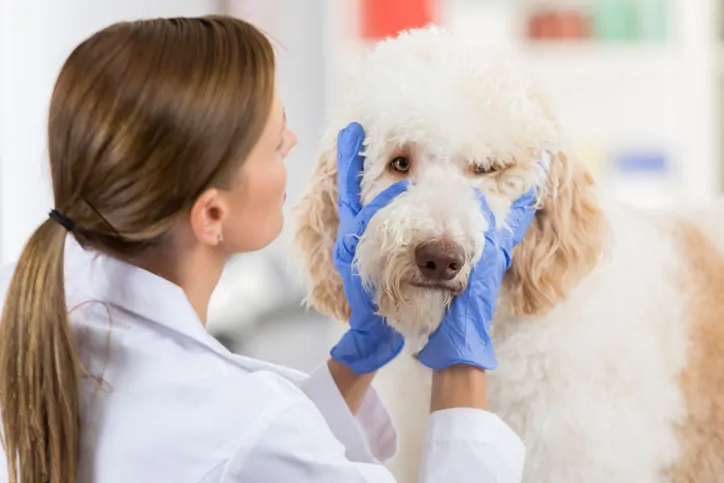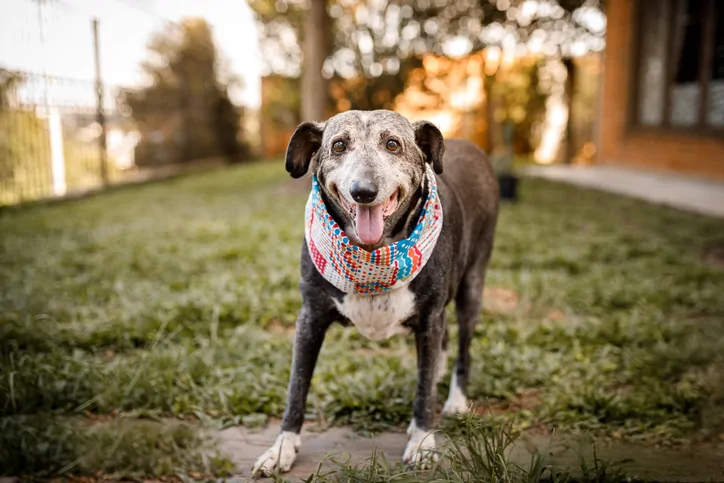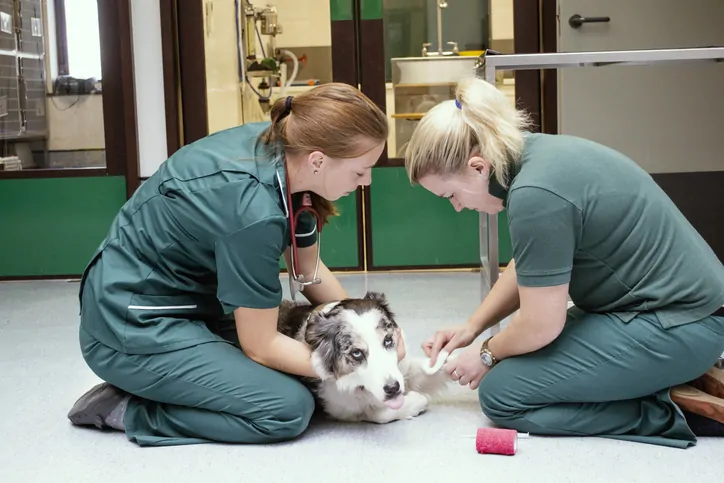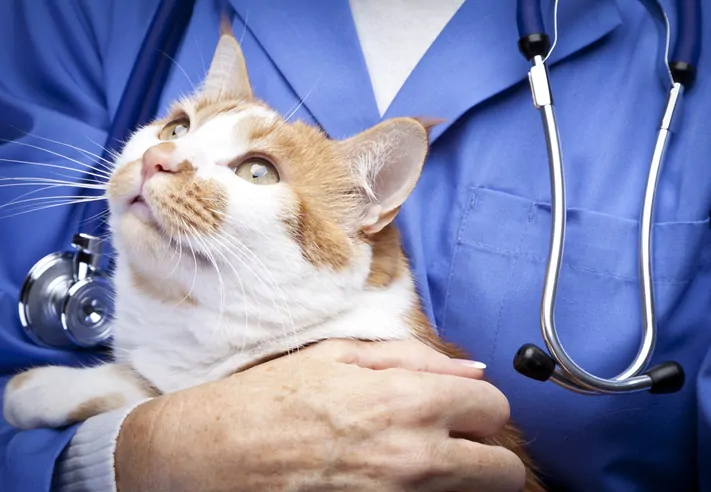Cats become infected with roundworms by ingesting worm eggs or nursing from infected mothers.
Roundworms are nematodes that occur as parasites within other animals and live primarily in their intestines.
Roundworm infection primarily causes digestive issues such as vomiting, diarrhea, and bloating, but can also cause anemia, weight loss, coughing, stunted growth, and vision loss.
Roundworms in cats are diagnosed through a stool examination, a fecal flotation test, or a protein antigen test.
Your vet will administer anthelmintic medication to your cat which kills parasites. Additional medication may be sent home or administered by your veterinarian at your cat's next checkup.
Staying on monthly, year-round prevention –routinely deworms them monthly as well as protects them from heartworm disease and fleas. Strict hygiene, rodent control, and periodic de-worming are a few ways you can prevent roundworms in cats.
The most common parasite that infects your cat is the roundworm. Roundworm infection occurs when cats ingest infected eggs or nurse from infected mothers. Also known as ascarids, roundworms use up the nutrients from your cat's food as it travels through their intestine, causing weakness. Roundworm infection in cats puts the whole family at risk as it can be spread to humans if they have an open wound when they pet an infected cat, clean litter boxes, or are otherwise exposed.

Roundworms are long, bilaterally-symmetrical nematodes that are tapered at both ends. Nematodes live in a variety of habitats, including soil, freshwater, marine, and deep water-filled crevices in the Earth's crust as well as in vinegar and beer malts. Nematodes, such as roundworms, exist as parasites in plants and animals. The roundworms found in cats average about 3 to 5 inches in length and are called Toxocara cati. Although Toxocara cati can spread to humans, the parasite does not mature to adulthood within a human host.
Roundworms pose a higher threat to kittens than they do to healthy adult cats. Regardless of age, cats with small worm populations may show no symptoms. While adult roundworms live in the intestines, roundworm larvae can travel throughout the lungs, liver, and other organs. These worms can cause damage to your cat's organ tissue, nerves, and even eyes. Other symptoms of roundworm infection include:
Significant numbers of worms moving into your cat's lungs may cause frothy nasal discharge, pneumonia, fluid in the lungs, breathing problems, and even death. Kittens suffer more severe complications from roundworm infestations that can include:
You may discover adult roundworms in your cat's poop or vomit. Adult roundworms have a white or light brown hue, and can be several inches long.
To diagnosis your cat, a veterinarian can perform a fecal flotation test. The test is performed by mixing a small amount of your cat's stool with a liquid solution which causes roundworm eggs to float to the top. Any eggs that are found may be examined under a microscope on a transparent slide.
False negatives are common because some cats are infected with immature roundworms that haven't reproduced yet. On occasion, adult worms are found in a cat's stool, which helps with diagnosis. Your vet could also use a test that detects a particular roundworm protein antigen in cat feces. Best practices dictate that your cat or kitten should receive roundworm treatment even if they test negative.
The good news is that roundworms are comparatively easy to treat in cats. Roundworms are treated with a de-worming medication, or anthelmintics, which kill parasites by causing paralysis or inhibiting the ability of young worms to mature into adults. Anthelmintic drugs that are effective for roundworm infections in cats include:
Over-the-counter dewormers are not recommended as a roundworm treatment for cats because roundworms have a complex life cycle. To be sure all adult roundworms and larvae are eliminated, your cat should be treated by your veterinarian. More roundworm treatments may be sent home or administered at your cat's next check-up.
If the right roundworm medication is administered promptly, the prognosis for roundworm infection is good. However, extremely diseased kittens sometimes pass away.
Roundworms can enter your cat's body in a variety of ways, therefore it's important to keep your cat's living space sanitized, and if at all possible, keep your cat inside to prevent them from consuming wild animals that might be roundworm carriers. Some other measures that prevent roundworm contamination are:
Strict hygiene can help prevent the spread of roundworms to humans. Symptoms of roundworm infection in humans include cough, fever, restlessness, stomach pain, vomiting, and wheezing. Adult roundworms may be present in human stool. Roundworms are treated in humans with a medicine that kills roundworms in around3 days.
Trauma-related corneal damage is the most common eye condition in dogs, followed by dry eye disease and conjunctivitis (pink eye).
Symptoms of common dog eye conditions include red or pink eyes, cloudy eyes, discharge, squinting, swelling, itchiness, and pain or distress.
Trauma is the most common cause of dog eye conditions, often in combination with a secondary infection.
Treatment for common eye conditions in dogs ranges from medicated eye drops and oral medications to surgical interventions.
Preventing eye conditions in your dog consists of avoiding situations where your dog's eyes may be injured along with maintaining regular wellness visits to detect any eye changes early.
Common dog eye conditions can range from little irritants, like allergies and minor scratches, to more severe conditions, like glaucoma and significant wounds. Whatever the underlying reason for your dog's eye condition, the most important thing is to act and seek veterinarian care as soon as possible because even minor eye issues can get worse.

The most common dog eye conditions are corneal damage, caused by trauma, followed by dry eye and pink eye. Other common eye issues in dogs include eyelid masses, cataracts, glaucoma, and cherry eye. Here are some of the symptoms your dog may have if they are suffering from one of these conditions:
Symptoms of common eye conditions in dogs may appear in one or both eyes. If you notice tearing, tear-stained fur, discharge, closed or squinted eyes, a visible third eyelid, or pupils of unequal size, your dog may be experiencing a serious eye condition and you should call your vet immediately to schedule a consultation.
There are several causes of eye conditions in dogs. The most prevalent dog eye issues are associated with trauma and certain eye conditions occur more in some breeds than others. Here are several eye conditions that commonly affect dogs:
Eye conditions in dogs need a proper diagnosis for effective treatment. Once your dog exhibits symptoms, take them to the vet because symptoms can escalate in a short period of time. Your vet can perform a series of tests to identify the issue and establish a treatment plan.
One of the first tests your vet may perform is the Schirmer tear test. This examination gauges your dog's ability to produce tears by placing small paper strips are placed beneath your dog's eyelids for one minute.
Your vet may also order a fluorescein stain which checks the surface of your dog's eye for blemishes, ulcers, and other abnormalities. It can also be used to assess the drainage and quality of tears. This test consists of the application of a green stain to each eye, followed by an examination of the eyes under a special blue light.
The most important test is the measurement of eye pressure. Certain eye conditions can induce changes in ocular pressure that can be painful and cause serious complications. A sensitive pressure-measuring instrument is used to tap the eye's surface throughout the procedure. Don't worry, numbing eye drops will be applied, so your dog will be comfortable during this process.
Blood tests and cultures may also be ordered to check for bacterial growth or other underlying conditions, depending on your dog's symptoms.
Your dog's physical examination and diagnostic test results will be used to guide the course of treatment. Here are a few typical remedies:
It's also good to know that many of the drugs offered as doggie eye "drops" are available as ointments. Your veterinarian can advise you on which option is best for your pup.
Unfortunately, not all eye issues can be avoided. However, there are certain things you can do to reduce the risk for your dog:
Avoid situations that could cause eye injuries, such as letting your dog run through bushes with pointed branches.
Have eye conditions treated by your dog's vet as soon as possible. If left untreated, eye issues can quickly worsen. Early intervention may prevent complications and keep your dog more comfortable.
Attend routine checkups as advised. Wellness checkups assist in spotting early warning signs of eye conditions in your dog and allow for quicker treatment and better outcomes.
While disorders such as glaucoma or deep ulcers may call for more intensive care, the majority of eye issues are easy to manage and have fast recovery times. So, it is likely that your dog will return to normal if you seek veterinary care for your furry family member as soon as their eye condition becomes noticeable.
For many pet guardians, their four-legged companions are their most loyal and loving friends. It's a bittersweet connection, knowing that, chances are, you will outlive your beloved pet, and be faced with that grief. Consequently, many animal lovers observe the signs of aging in their pets with trepidation. However, pets age in stages, and, like with the aging humans in our lives, their golden years are an opportunity for us to treasure our time with them and show our gratitude for the love and laughter they bring to our lives.

Small dogs and cats are typically categorized as "seniors" at seven years old. In comparison to smaller breeds, larger breed dogs tend to live shorter lives and are frequently regarded as “seniors” around the age of 5 to 6 years old. Pets are surviving longer than ever thanks to advances in veterinarian treatment and dietary practices but may still experience age-related issues. Nevertheless, with the right care, your furry family member can age happily, healthily, and actively.
Dogs and cats experience many of the same age-related health issues but the signs of illness can manifest in different ways. Signs of aging in dogs include:
Cats show more subtle signs of aging than dogs, so you may have to be especially observant with your elderly cat. The signs of aging in cats include:
Noticing signs of aging in your pet does not mean it's time to panic, it simply means your pet may need extra care and attention going forward. Subtle changes to your pet's routine, vet care, and changes to their environment can help them stay healthy longer.
No matter what species your pet may be, all elderly pets benefit from semi-annual veterinary visits, geriatric diets, low-impact exercise, and changes to their environments. Semi-annual veterinary visits make it possible for vets to detect signs of illness quickly for more effective treatment and better outcomes. Doing senior blood work every 6 months to a year for early detection is key.
Parasite control and dental care are also vital to the health of older pets. Your vet will perform more in-depth examinations as your pet ages and may do periodic lab work to check your pet's liver and kidney function.
Geriatric pet diets consist of easily digestible ingredients with calorie levels that are more appropriate for aging pets and include anti-aging nutrients. Your vet can recommend the best formula of high-quality pet food for your pet's specific needs.
Low-impact exercise helps keep aging pets active, eases joint pain, and improves mobility. For pets who suffer from arthritis, specialized diets, joint supplements, and anti-inflammatory medicines formulated for pets may ease your pet's symptoms and help them feel like being more active. Alternative therapies for pet arthritis include acupuncture, electron conversion therapy, chiropractic care, and stem cell therapy. In extreme cases, your vet may use a surgical approach by removing damaged tissue or replacing worn joints.
Assistive changes to your pet's environment can help them maintain their daily routines. Providing soft, non-slip surfaces for pets to walk on and ramps for climbing into cars or onto couches help many pets with mobility issues. Keeping your pet warm and supplying them with comfortable bedding soothes joint pain.
Some of your pet's care needs may be species-specific. For instance, dogs need more exercise and activity to stay mobile than cats do. Elderly cats who aren't feeding well benefit from having water and food bowls in several places around the house so they don't have to go far to feed, whereas, dogs are better served by providing elevated food bowls. Dogs benefit from the use of support slings for assistance with walking and climbing into the car but such devices are of little use to cats.
If your pet has a serious condition and there is no hope of recovery, pet hospice care, referred to as palliative care, is an option. The idea is to utilize the right combination of painkillers, nutritional modifications, and human interaction to make your pet's final days or weeks more bearable. Pet hospice is not a physical location, but rather a philosophical and personal decision based on the idea that dying with dignity is both possible and a natural part of life. Pet owners should be cautious not to prolong the suffering of animals who are in pain or have a poor quality of life when considering hospice care.
If your pet is suffering, the most compassionate option may be euthanasia. Euthanasia can end your beloved pet's suffering without pain. Veterinarians receive specialized training to provide your pet with a dignified and humane end. The process involves an injection of a sedative, followed by an injection of a specific drug. The treatment, which lasts between 10 and 20 seconds, is comparable to receiving general anesthesia during surgery and causes the animal to have no awareness of what is happening.
Following the loss of a cherished pet, it's common to experience a range of difficult emotions. No matter what you are feeling, remember that there is no right way to mourn. Try to remember the good times and build a support system that includes people who loved your pet as much as you. if the intensity and duration of your grief become overwhelming, it is best to talk to your doctor or a mental health professional to develop a treatment plan that can help you feel better moving forward.
If your pet's wound is deep, includes bite marks, has a deep puncture hole, has become infected, or your pet show signs of pain, then your pet needs veterinary attention.
Depending on the type of wound, your pet may need antibiotics, stitches, surgical debridement, or a Penrose drain.
Apply pressure to stop bleeding from your pet's wound, then clean it with antibacterial soap and rinse well. Light ointment and bandaging may be needed as well as an e-collar to prevent your pet from licking the wound.
Pets often suffer from cuts and scrapes and minor injuries that can usually be treated at home. However, because most pets are covered with thick fur coats, it can be difficult to see if the injury is serious.
When inspecting a wound on your pet, exercise caution. When in pain, any pet may bite, even if they are usually very docile. Wrap your pet in a towel or a muzzle to be safe.

Sometimes when your pet is wounded, it's obvious that they need veterinary attention right away. However, cats and dogs are notoriously stoic, so it's possible for their injuries to seem minor when they are actually quite serious. Some things to look for when assessing your pet's condition are:
Your vet will carefully examine your pet, assess their wounds, and look for any other injuries. For examination purposes, your pet's hair may be removed. X-rays could also be required for some wounds. Some sedation may be necessary to keep your pet calm during the examination.
The goal of wound care is to prevent infection from taking hold and spreading while permitting the wound to heal. Different approaches are needed to achieve these objectives for various types of wounds. To treat the wounds properly and without exacerbating your pet's agony, sedation or anesthesia is typically required. Various wounds and their treatments include:
When your pet is ready to go home, your vet will provide instructions about how to clean and change your pet's bandages as well as any antibiotics or pain medications your pet may need.
If there's a drain in place, let the fluid drain from the wound before using a warm, moist towel to gently clean up the debris and avoid clogging the drain. To prevent your pet from licking the wound and making it worse or from removing sutures or drains, use an Elizabethan collar.
If your veterinarian has to remove a drain or stitch or do a recheck examination, do so promptly. Even brief delays might harm your pet and lengthen the recovery process.
Minor wounds such as small cuts and scrapes may be treated at home and observed for signs of infection. The following steps can prevent infection in your pet's wound:
If the wound develops signs of infection such as redness, swelling, odor, discharge, or heat at the wound site, take your pet to their veterinarian's office as soon as possible.
If your dog is experiencing allergy issues, you may observe excessive itching and scratching, red and watery eyes, sneezing or runny nose, vomiting or diarrhea, and a variety of other symptoms.
Dogs are allergic to many of the same things that humans are including pollen, mites, fleas, detergents, and some food ingredients.
Allergies in dogs may be diagnosed with food trials, blood tests, and skin tests.
Allergies are managed rather than cured with flea prevention, lifestyle adjustments, symptom management, and weekly allergy shot therapy to build your dog's tolerance to allergens.
If your dog has allergies, they may scratch and lick their skin every hour of the day and even wake you up at night. Perhaps, you've also observed signs of intestinal discomfort or typical allergy symptoms in your dog. While these types of allergy reactions are mild, it's best to determine the source of your dog's allergy issues before itchy spots become open wounds and runny noses become respiratory infections. Here's what you need to know about managing your dog's allergic condition.

Allergies are a result of an overreaction of your dog's immune system to harmless substances in the environment such as dust, pollen, fleas, or certain food ingredients. Your dog's immune system is wired to respond to pathogens like viruses, bacteria, or fungi. When there is an aggressive response to non-pathogenic substances, that reaction is referred to as an allergy.
During an allergic reaction, histamine is released causing inflammation. The most typical allergy signs in dogs are as follows:
The most serious sign of an allergic reaction is anaphylaxis, a life-threatening reaction that manifests as facial swelling, difficulty breathing, sudden diarrhea or vomiting, and collapse. Fortunately, this condition is rare in dogs, but if you notice these signs in your pet, take them to the vet immediately.
Not all allergic dogs experience the same symptoms. Mild to severe symptoms are possible and may impact different parts of the body. Your dog may be hypersensitive to a wide range of allergies. Some dogs may only have one sort of allergy, while others may have several. The most typical dog allergies are:
Most allergies are hereditary or genetic in nature. Bulldogs, Chinese Shar-Peis, Retriever and Terrier Breeds, Shih Tzus, and Lhasa Apsos are a few dog breeds that may be more prone to allergies. However, any breed of dog can be affected. If your dog is predisposed to allergies, they manifest between 6 months and 3 years old. Canine allergies may change with the seasons or if your dog moves to another region.
Testing for allergies takes time. Your veterinarian will start by eliminating any medical or emotional disorders that could result in comparable symptoms. For instance, microscopic skin mites can create sensations on the skin that resemble allergies, yet some allergy therapies can actually make skin mites worse. Additionally, like some people chew their fingernails, an anxious or bored dog could lick or chew their skin.
The following are typical next steps if allergies are suspected:
These tests are frequently tailored to include allergens unique to your dog's region, state, or city.
Keep in mind that treating allergies means managing them, not curing them. You may set reasonable expectations, prevent disappointment, and develop the best long-term management strategy by keeping this objective in mind. Managing your dog's allergies may include actions such as:
Your dog's allergies can be frustrating for both you and your dog. Fortunately, you can make your dog feel better so they are able to enjoy all their favorite activities with you, itch-free, by being patient, vigilant, and following your veterinarian's instructions.
Cat allergies are caused by an over-reactive immune response to typically harmless substances in your cat's environment or food ingredients.
Common, observable signs of an allergic reaction in cats include red, itchy, watery eyes, hives, scratching ears or pawing at the face, itchy rashes, and runny nose or sneezing as well as vomiting and diarrhea.
Veterinarians perform food trials, skin testing, and blood tests to identify the cause of your cat's allergy symptoms.
Treatment for allergies in cats consists of managing your cat's exposure to irritants and supportive care for their symptoms or weekly injections to boost their tolerance to known allergens.
Limiting your cat's exposure to known allergens, keeping a dust-free environment, preventing your cat from going outside, and giving your cat vet-approved supplements are some of the ways you can reduce the frequency of your cat's allergic reactions.
Allergies may cause your cat to scratch and lick, even to the point of getting bald patches or wounds. They may also exhibit intestinal discomfort or symptoms like hay fever. Most allergic reactions in cats may present with mild symptoms but increase in severity over time or come on without a known cause. That's why it is important to consult with your veterinarian to determine the reason for your cat's allergy symptoms and develop an allergy management plan.

When your cat's immune system overreacts to otherwise harmless substances in their environment, it is considered an allergic reaction. For instance, their immune system may respond to items like pollen, dust, or an ingredient in your cat's food as though they were pathogens like viruses or bacteria.
Histamine, which is released as part of the immune system's protective response, can cause inflammation, itching, or difficulty breathing as well as vomiting and diarrhea. This may manifest as conditions of the skin, digestive system, or upper respiratory system. The most common signs of allergies in cats are:
Anaphylactic reactions may cause facial swelling, vomiting or diarrhea, breathing difficulties, collapse, and even death. The good news is that anaphylactic reactions to seasonal, flea, or food allergies are rare. However, you should take your cat to a veterinarian right away if you notice any of these symptoms, particularly after a bee bite, vaccination, or new medicine.
Several allergy signs may be present in your cat at one time, or only one or two may be observable. However, any one of these signs, especially if they manifest, is enough to suspect allergies as the underlying cause. In such cases, it's recommended to visit your veterinarian so they can diagnose and treat your cat.
A range of allergies with mild to severe symptoms may affect many different parts of your cat's body. Some cats are hypersensitive to a wide range of allergens. while others may only experience one specific allergy. The most common types of cat allergies include:
Most allergies are hereditary or genetic in nature. Unfortunately, this makes it challenging to prevent allergies. Any cat can experience allergies, regardless of age, and any cat breed can be susceptible.
Testing for the allergen(s) that trigger your cat's immune response may take time. However, any details you can give your veterinarian about what your cat is exposed to in their environment can help narrow your vet's search area and allow for a faster diagnosis. Your vet will perform diagnostic tests to help identify the cause of your cat's allergy symptoms such as:
It takes a thorough investigation to determine what triggers your cat's allergy symptoms due to the fact that there is a wide range of allergens that can cause similar symptoms.
If your cat's allergy is flea-related, it only takes a few bites from a flea to cause a life-threatening allergic reaction. Year-round flea prevention is the best way to protect your pet from allergic reactions to flea saliva. Fleas have the ability to survive in even the coldest weather. Your veterinarian can recommend the best flea preventative for your cat.
If food allergies are the source of your cat's allergy symptoms, they must adhere to a strict diet consisting of foods that are unlikely to trigger allergy symptoms. Your veterinarian can assist you in locating substitute medications and hypoallergenic food that your cat is able to tolerate.
Environmental allergies and seasonal allergies are tricky since you can't regulate the pollen count, and environmental allergens are more difficult to manage. Depending on the severity of your cat's symptoms, seasonal allergies may require long-term therapies and drugs that are given either at regular intervals or only when an attack occurs.
Desensitization therapy is another option to explore if your cat has environmental allergies. This entails once-a-week injections personalized for your pet based on their allergy test. Minuscule amounts of your pet's allergens are present in the injections, which allows your cat to develop a tolerance. While it can take months for the injections to start working and not all cats will see a noticeable difference, it may still be worth the effort for cats with severe allergy symptoms.
Other interventions you might try to limit allergic reactions in your cat include:
Allergies are frustrating for both you and your cat. If you have the right allergy management plan, you can help your cat feel better. This plan can allow you and your cat to enjoy all their favorite activities without uncomfortable symptoms such as itchiness.
The Thanksgiving holiday is a time for family, friends… and food. Lots and lots of food. For many pet owners, this can be a stressful time, as they worry about their furry friends getting into the holiday feast. However, with a little planning and preparation, you can keep your pet safe and enjoy the holiday season stress-free. By following our simple tips, you can help to ensure that your pet has a safe and happy Thanksgiving.

Pets beg because they know it works. But resist the temptation to give in and feed them table scraps. Fatty foods can cause pancreatitis, an inflammation of the pancreas that can be life-threatening. Turkey skin is also a hazard because it can get stuck in your pet's throat or cause an intestinal blockage. And chocolate is poisonous to dogs and cats, so keep those dessert plates out of reach!
Here are some unsafe foods that pets can NOT consume:
• Turkey bones, turkey skin, and turkey gravy
• Ham
• Yeast dough/raw dough
• Grapes
• Onions
• Garlic
• Stuffing
• Casseroles
Here are some safe foods that pets CAN consume:
• Turkey meat
• Cranberries
• Pumpkin
• Apples
• Carrots
• Green beans
• Sweet potatoes
If you notice that your dog has eaten something from the unsafe foods list, it is important to seek veterinary care immediately. If he/she reacts badly after consuming a food item marked as "safe" then there might be an allergy or other issue with this particular meal, and they should see their vet right away!
With all the hustle and bustle of Thanksgiving, it's easy to forget about your furry friends. But leaving them alone for too long can be stressful and dangerous. If possible, have someone check on them every few hours to make sure they have food, water, and a clean litter box or yard. And never leave them unsupervised around candles, fireplaces, or space heaters.
With all the coming and going on Thanksgiving Day, it's important to keep your pets away from the door to prevent them from slipping out unnoticed. Put up a baby gate or keep them in a quiet room where they can't get underfoot or escape.
Thanksgiving is a great time to spend with family, friends and loved ones. However, it’s also important to remember that your pets are an important part of the family as well. That’s why we want to remind our readers to keep their pets safe this holiday season. Be sure to keep them away from any food or drinks that may be harmful and always have plenty of fresh water available. If you need help keeping your pet healthy and safe during the holidays, don’t hesitate to call us. We would be more than happy to offer advice or book an appointment for your furry friend. We believe by following these simple tips, you can help ensure that your pets have a happy and safe holiday season!
As the leaves start to change color and the temperature begins to drop, we know that fall is officially here. For many of us, that means pumpkin spice lattes, cozy fires, and watching our favorite football team on Sundays. But for our furry friends, Fall can pose some hazards that pet parents need to be aware of. Here are a few tips on how to keep your pet safe this season.

Pets and Halloween candy are a dangerous combination. According to the ASPCA Animal Poison Control Center, chocolate is the number one toxin pet parents need to be aware of during Halloween. Dogs especially are attracted to the smell and taste of chocolate, but it can be very harmful—even fatal—if ingested in large quantities. So be sure to keep your Halloween candy out of reach of your furry friends!
The Holidays can be full of tempting treats for your pet, but many common holiday foods are actually poisonous for animals. Don't let your pet eat any candy, chocolate, raisins, grapes, or nuts, and be careful with foods that contain onions or garlic. Turkey skin can also be problematic for pets, as it can cause pancreatitis. Keep all food out of reach of your animal companions, and make sure they have plenty of toys and attention, so they don't feel left out while you're busy cooking.
Another hazard to pets during the fall season is cold weather. While we can bundle up in a warm coat when the temperature starts to dip, our pets can't do the same. If you live in an area with cold winters, make sure your pet has a warm place to sleep inside your home. You may also want to invest in a doggie sweater or coat for extra protection when they go outside. Just like us, cats and dogs can get colds when they're exposed to chilly temperatures, so if you notice your pet sneezing or coughing more than usual, it's time for a trip to the vet.
Finally, autumn is peak season for ticks and fleas. These pesky critters love nothing more than to hitch a ride on our four-legged friends and make themselves at home. Not only are they annoying, but they can also transmit diseases like Lyme disease and Rocky Mountain spotted fever. Be sure to keep up with your pet's flea and tick prevention during the fall months (and year-round!) and check them for any unwanted visitors after they've been outside playing.
Need your preventatives this Holiday season? Bring your pet into My Pets Wellness for their wellness exam so we can make sure your pet is happy & healthy this holiday season. By following these simple tips, you can help ensure that your furry friend has a safe and happy fall season!
Urinary tract infections, or UTIs, in cats can be excruciating and, if left untreated, can lead to severe complications. Therefore, it's important to keep an eye out for the symptoms of urinary tract infections in cats. Common signs and symptoms you may notice in your cat include:
Urinary tract symptoms are common in cats, especially if they are 10 years or older. Though, we see cases anywhere from 2 years old and on. The urine in your cat's bladder should be sterile, but if bacteria get into the bladder, they can multiply and spread throughout the urinary tract, causing infection, however, such cases are rare.
Endocrine disease contributes to the majority of urinary tract infections in cats and is characterized by the overproduction or underproduction of hormones by the endocrine glands. A disordered adrenal gland, thyroid gland, or pancreas can cause your cat to have excessive thirst, frequent urination, and dehydration.
Low-level, chronic dehydration increases the chance of your cat developing a urinary tract infection because a dehydrated urinary tract allows bacteria to develop and reproduce more efficiently. Kidney failure later in your cat's life may be connected to persistent or untreated urinary tract infections.

Feline lower urinary tract disease, or FLUTD, is a general term that covers a wide range of urinary tract symptoms, which are very common. With FLUTD, crystals, stones, or debris can slowly accumulate in your cat's bladder or urethra, resulting in an obstruction that can impede bladder emptying. If neglected, these illnesses can become serious or even fatal.
For cats with FLUTD, urinating might be difficult, uncomfortable, or even impossible. Additionally, they can urinate more frequently or improperly outside of their litter box (occasionally on surfaces that are cool to the touch such as a tile floor or bathtub).
Although cats of any age can get feline lower urinary tract disease, it's most common in cats that are overweight and middle-aged who have limited to no access to the outdoors, eat a dry food diet, or do not get enough physical activity. Because their narrower urethras are more likely to become obstructed, male cats are more vulnerable than female cats to developing a urinary disease.
Whether your cat has a UTI or FLUTD, both conditions require veterinary care. Contact your veterinarian or the closest emergency vet right away if your cat is struggling to urinate or howling in agony as your cat may be having a medical emergency.
Your veterinarian will conduct a thorough physical examination to help determine how your cat is feeling and will conduct a variety of tests to learn what is causing your cat's urinary tract symptoms, such as:
Some tests may take longer to perform than others so your veterinarian may prescribe a broad-spectrum antibiotic to start your cat on until the results come in. Once all the test results are completed, your vet will provide you with a more targeted treatment plan for your cat.
Once your vet has identified the exact cause of your cat's urinary symptoms and prescribed a treatment plan, it's important to follow their instructions precisely and give all prescription medications as directed and on time. Making sure your cat has plenty of water close by during recovery and making vet-recommended changes to their diet may also speed the recovery process.
Yes. Heartworm can be found in all 50 US states. It is more prevalent in the south and in areas with larger populations of mosquitos.
Heartworm is spread by mosquitos. It is not spread directly between mammals. For example, a human cannot get heartworm from a dog.
Dogs and ferrets are the most at risk; however, cats can become infected as well. Especially in the case of ferrets, prevention is very important as it can be hard to treat once infected.
Yes! Heartworm is a serious illness that can kill your pet. Proper preventative measures are essential to keeping your animal safe.

Heartworm disease in pets is a severe and sometimes fatal condition in the United States and many other countries around the world. Dogs, ferrets, and to a lesser degree, cats are susceptible to heartworm disease, which is caused by foot-long worms that reside in the lungs, heart, and arteries. These worms also find hosts in wolves, foxes, coyotes, sea lions, and in a few instances, humans. Heartworms can cause heart failure, severe lung disease, and other species-specific health consequences:
Canines serve as natural hosts for heartworms, fostering the worm's maturation into an adult worm. After that, the parasite will reproduce and produce offspring. There have been reports of dogs harboring hundreds of worms, and if left untreated, this number can increase exponentially. Heartworm disease causes irreversible damage to a dog's heart, lungs, and arteries, impacting its health and quality of life even after the parasites have been eliminated. This makes heartworm prevention very important for dogs. If your pet becomes ill, treatment is required, and it should start as soon as possible as the worms can multiply exponentially.
While cats can become infected, it is less common. Cats infected with heartworms usually have no more than one to three adult worms in their bodies and sometimes have no adult worms at all. Heartworm sickness in cats is frequently misdiagnosed, but it's important to know that even juvenile worms can harm cats. The juvenile worm causing heartworm linked respiratory disease (HARD). Cats can only be protected from the effects of heartworm disease through prevention because the medication used to treat heartworm infections in dogs is not safe for cats.
Ferrets are susceptible to heartworm, but treatment options are less available. Like cats, ferrets' smaller heart size makes them susceptible to fatal damage from even a tiny number of worms, perhaps as few as one. Heartworm disease in ferrets is difficult to diagnose, and there is no reliable cure. For ferrets prevention using a heartworm prophylactic medicine is highly recommended.
While there may not be any symptoms in the early stages of infection, symptoms of disease will start to show as the worms mature and multiply, intensifying the severity of symptoms as they spread. Here are the four classes of heartworm infection:
Only mosquitoes can spread heartworms from one animal to another. Microfilariae, which are immature heartworms, enter the mosquito's system when it bites an infected animal. Within two weeks, the microfilariae inside the mosquito transform into infectious larvae, which transfer to other mammals as the mosquito feeds on them. Contrary to dogs, infected cats do not frequently have microfilariae circulating in their blood, and so are less likely to spread the heartworm infection to another mosquito.
Within six months, the infectious larvae develop into adult heartworms. The larvae travel through the animal's body during the first three months before arriving at the lungs' blood arteries. The young worms spend the last three months maturing with females reaching lengths of up to 14 inches. Severe lung and heart illness are caused by the damage adult worms cause to the blood arteries and to the heart's capacity to pump blood. By the time the animal starts to exhibit the signs of adult heartworm infection, it already has heartworm disease.
When both sexes of adult worms are present, they will procreate new microfilariae within five to seven months after infection. The immune system of the animal may mount a response to the microfilariae that may harm other organs in the process. When a mosquito attacks an infected animal and picks up the microfilariae, the life cycle is recommenced. Infectious heartworm larvae can infect other mammals 10 to 2 weeks after developing from microfilariae to infective larvae inside the mosquito. In dogs, adult heartworms can live for five to seven years, while in cats, they can live for months or even years.
According to a Stanford University study, the first case of canine heartworms in the United States was found in the Southeast in 1856. The American Heartworm Society warns that heartworms are spreading across the nation and around the world, despite it earlier being more prevalent in the Atlantic and Gulf coast states. While the Southern U.S. has historically been linked to heartworm disease, pets in all regions of the country are at risk for heartworm disease at any time of year. All fifty states have reported cases of the sickness, according to the U.S. Food & Drug Administration.
Even dogs who spend most of their time inside are not completely protected from mosquito bites in areas with high numbers of stray or wild animals. Moving pets from one state to another may bring heartworms into areas where it has not previously been an issue. This is particularly evident with dogs from heartworm-endemic areas that are brought into shelters outside their home region during disaster relief operations. For instance, during Hurricane Katrina in 2005, over a quarter of a million animals were relocated from the New Orleans region to new residences across the nation. Some of these canines brought heartworms with them. According to AHS, there are more than a million heartworm-afflicted pets in the United States.
Phone: (855) 461-8259
Email: [email protected]